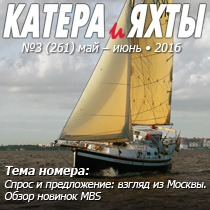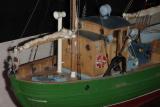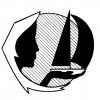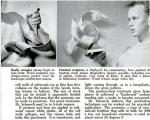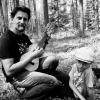
Средство для выгибания древесины.
#1

Отправлено 26 апреля 2010 - 12:20
#2

Отправлено 26 апреля 2010 - 13:29
над буком такие опыты хорошо проходятИнтересна любая информация по вопросу.
С уважением.
http://www.reaa.ru/c...?num=1196361852
#3

Отправлено 26 апреля 2010 - 14:35
#6

Отправлено 26 апреля 2010 - 20:25
http://t22.nm.ru/Steambend.htmОбращаюсь за помощью в поиске средства, применяемого для гнутья древесины. ......... Интересна любая информация по вопросу.
#7

Отправлено 27 апреля 2010 - 00:58
А кто использует бук в судостроение? Гнуть можно с применением пара или ламелями.насчет "бук не гнётся". На фото планширь и привальник выполнены как раз из согнутой рейки бука. В планшире снизу ещё и паз был пропилен (на прямой рейке до сгибания), которым планширь на борт садится.
Гнулось всё над паром от чайника.
Сечение планширя примерно 10х6мм.
#8

Отправлено 27 апреля 2010 - 09:16
#10

Отправлено 27 апреля 2010 - 11:44
How to Bend Wood to Make Furniture
http://www.ehow.com/...-furniture.html
Сообщение отредактировал Aleksk: 27 апреля 2010 - 11:46
#11

Отправлено 27 апреля 2010 - 12:16
Chemical Methods
Chemicals such as urea, urea-adehyde and ammonia have been used to soften the matrix that holds wood fibers together. In tests conducted at the Forest (Naut.) at the fore royal masthead; - said of a flag, so raised as a signal for sailing, etc.
See also: Fore Products Laboratory, urea-treated wood did not bend as easily and developed more stress failures than steamed wood.
Back in 1964, scientists at the New YorkNew York, state, United States
New York, Middle Atlantic state of the United States. It is bordered by Vermont, Massachusetts, Connecticut, and the Atlantic Ocean (E), New Jersey and Pennsylvania (S), Lakes Erie and Ontario and the Canadian province of
..... Click the link for more information. State College of Forestry at Syracuse discovered that ammonia would soften the matrix bonds in wood, with both anhydrous an·hy·drous
adj.
Without water, especially water of crystallization.
--------------------------------------------------------------------------------
anhydrous (anhī´drus),
adj without water.
--------------------------------------------------------------------------------
anhydrous
containing no water. ammonia and compressed gaseous ammonia used in varying degrees of success. The scientists found that ammonia breaks down the hydrogen bonds within cell walls and within the lignin matrix. This allows molecular movement when subjected to tensile or compressivecom·pres·sive
adj.
Serving to or able to compress.
--------------------------------------------------------------------------------
com·pressive·ly adv.
..... Click the link for more information. forces. Once the ammonia evaporates from the wood, new bonds are made creating a permanent set; in simple terms, this can be considered similar to the process of adding a permanent wave to hair.
The process is reversible by further ammonia treatment. Chemical set is not recoverable by treating with hot water or steam; unlike with steam and hot water bending treatments, no stresses or strains are bent into the wood. Thus, the new shape is like other kiln or air dried wood. It is ready to be machined, glued and finished.
Several experiments with ammonia have shown that wood, especially hardwoods, can be used to make numerous unique furniture designs. It has also been used to help disintegrate dis·in·te·grate
v. dis·in·te·grat·ed, dis·in·te·grat·ing, dis·in·te·grates
v.intr.
1. To become reduced to components, fragments, or particles.
2. wood in the manufacture of hardwood panels and chipboards. The process may also clear the way for better utilization of raw materials and new, economical designs.
Experiments with Anhydrous Ammonia
Several experiments with anhydrous ammonia in pressurized pres·sur·ize
tr.v. pres·sur·ized, pres·sur·iz·ing, pres·sur·iz·es
1. To maintain normal air pressure in (an enclosure, as an aircraft or submarine).
2. vessels have been highly successful. Pressure vessels are used because the anhydrous ammonia vaporizes and dissipates at atmospheric pressures and temperatures above -28F.
However, processing in pressure vessels has several drawbacks, especially for special, or low production activities. Personnel must be trained and certified to compress and use pressure vessels. Pumps, vessels large enough to hold various sizes of wood lengths and recovery systems are expensive.
Anhydrous ammonia is kept in a pressurized tank to keep it liquid. It is highly corrosive to aluminum, brass and copper, and presents considerable health hazards. Iron or steel must be used anywhere ammonia vapor or liquid contacts metal. It can cause frost burns and serious damage to the nose, lungs and eyes.
Alternate Experiment
For short runs or one-of-a-kind special designs, a simple soak tank can be used. [ILLUSTRATION FOR PHOTO 1 OMITTED]. Standard filling fittings used for charging anhydrous ammonia can be welded to a steel tank/pipe. Since this is not a pressure vessel, a filler pipe should be extended to within 50mm of the bottom to reduce spillage and boiling of the liquid ammonia during fill.
The tank should be slowly filled with anhydrous ammonia in an open area or field. A vent pipe on the lid of a pipe tank allows fumes fumes
odorous gases and other volatile materials; inhalation of irritating fumes causes coughing and, if sufficiently severe, irreversible pulmonary edema. to be directed away from the operator during filling. Remember, ammonia evaporates at room temperature. The colder it is outside during this operation, the slower the anhydrous ammonia vaporizes. During hot weather, vaporization vaporization, change of a liquid or solid substance to a gas or vapor. There is fundamentally no difference between the terms gas and vapor, but gas is used commonly to describe a substance that appears in the gaseous state under standard conditions of will be more rapid. It may be necessary to refill the tank in order to keep the wood covered at all times.
Wood specimens should be soaked in the ammonia for about five or more minutes per millimeter of thickness. It may be necessary to use iron weights to keep the buoyant wood pieces submerged. At least 90 minutes soak time are required for 18mm thickness. Additional soaking time is required for 18mm thickness. Additional soaking time may be required for some species or denser woods. In any bending process, the stock should be as straight grained and free from knots or grain figure as possible.
Results of using a "soak" chemical method were quite successful. Wooden strips approximately 6mm by 600mm were covered for about 35 minutes. The anhydrous ammonia was then drained onto the ground and allowed to evaporate. Specimens could be bent within one hour after removal from the soak tank. Red oak, American cherry, western cedar, Philippine mahogany and American black walnut black walnut
see juglans nigra. were easily bent in a variety of jigs and by freehand See Macromedia FreeHand. . [ILLUSTRATION FOR PHOTO 2 OMITTED].
Allow bent pieces to "de-gas" for 48 hours in a well-ventilated room before removal from bending jigs. Bending jigs can be as simple as a "peg mold." [ILLUSTRATION FOR PHOTO 3 OMITTED] A 6mm American cherry dowel dowel /dow·el/ (dou´'l) a peg or pin for fastening an artificial crown or core to a natural tooth root, or affixing a die to a working model for construction of a crown, inlay, or partial denture. was simply bent around a coffee can and held in place with hand clamps. The result is a cherry spiral or spring. [ILLUSTRATION FOR PHOTO 4 OMITTED].
The most common bending failure resulted from a buckling or wrinkling in the fiber walls caused by compressive failure on the concave side. Walnut and oak were reluctant to bend as sharply as birch, cedar and Philippine mahogany. Some oak and walnut specimens broke from tension failures on the convex side. Wood can be stretched only about 2 percent in tension, but more than 30 percent in compression.
You can expect color changes in all specimens. Many of the walnut specimens lost much of their color. These results were actually positive because all specimens took stain and finish very evenly. Light colored species absorbed color from darker species.
One contractor used a soak tank on-site to bend previously milled 18mm thick oak strips. The softened pieces were simply attached to a box frame for the bar and overhead shadow box/glass holder. The bar was then finished and hardware installed. [ILLUSTRATION FOR PHOTO 5 OMITTED].
In another example, the contractor used the wall as a forming jig jig, dance of English origin that is performed also in Ireland and Scotland. It is usually a lively dance, performed by one or more persons, with quick and irregular steps. When the jig was introduced to the United States, it was often danced in minstrel shows. . Previously milled oak was soaked for more than two hours and then simply nailed to the wall nailed to the wall - [like a trophy] Said of a bug finally eliminated after protracted, and even heroic, effort. . Sanding and finishing was completed in place. [ILLUSTRATION FOR PHOTO 6 OMITTED].
To summarize, use of anhydrous ammonia will make wood thermoplastic A polymer material that turns to liquid when heated and becomes solid when cooled. There are more than 40 types of thermoplastics, including acrylic, polypropylene, polycarbonate and polyethylene. enough to be bent. Heat treating specimens may aid in the bending process. Working in a cold climate will slow the evaporation of ammonia but reduce some of the plasticizing effects.
Terry Richardson For other persons of the same name, see Terry Richardson (ice hockey).
Terry Richardson (born 1965) is an American photographer.
Richardson was born in New York City, raised in Hollywood, California, and is the son of fashion photographer Bob Richardson. , PhD, is a professor in the Industrial Technology Department at Northern State University, Aberdeen, SD. He can be reached at (605) 626-2638 or by E-mail at: richardt@wolf.northern.edu
COPYRIGHT 1997 Vance Publishing Corp.
No portion of this article can be reproduced without the express written permission from the copyright holder.
Copyright 1997, Gale Group. All rights reserved. Gale Group is a Thomson Corporation Company.
#14

Отправлено 28 апреля 2010 - 20:41
Про навоз слышал ))),Благо лошади у нас есть и с навозом проблем нэт.В походных условиях - только в теплом конском навозе. Это не шутка, если что.
И все же , не теряю надежды найти концы немецкой пропитки ...
Будете на Валааме - надеюсь встретимся .
921 934 3744 Аркадий.
С июня по октябрь.
#16

Отправлено 22 мая 2010 - 23:02
В походных условиях - только в теплом конском навозе. Это не шутка, если что.
Это очень интересно,не стоит пренебрегать таким ресурсом,у меня под боком кони и куча навоза,которая шаит,ну или парит всегда,замочить шпангоуты и туда на ночь,может больше.Надо попробовать
#17

Отправлено 23 ноября 2010 - 11:42
Интересно, что у Вас получилось?Это очень интересно,не стоит пренебрегать таким ресурсом,у меня под боком кони и куча навоза,которая шаит,ну или парит всегда,замочить шпангоуты и туда на ночь,может больше.Надо попробовать
Мы пошли по старому и провереному пути переклея ламелями.
Контакты немецкой пропитки все ещё требуются.
Ответить
Количество пользователей, читающих эту тему: 0
0 пользователей, 0 гостей, 0 скрытых пользователей



